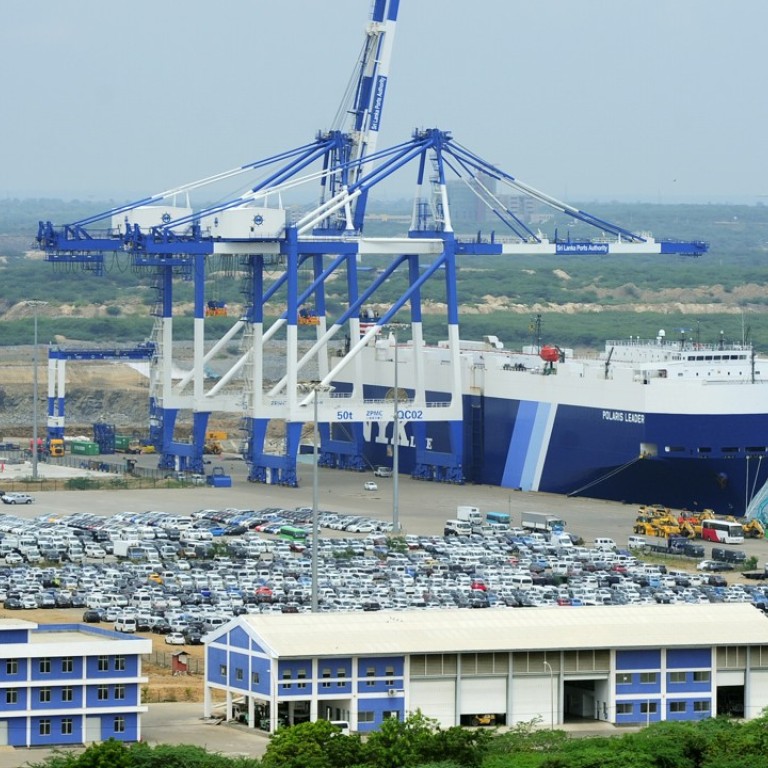
China’s belt and road projects ‘narrow economic inequalities within countries’
Chinese development finance corresponds to rises in subnational GDP, suggests report by US researchers
Chinese infrastructure projects do help narrow economic inequalities within host countries even if they risk tempting them into possible debt traps, according to US researchers.
Beijing’s trillion-dollar “Belt and Road Initiative”, which aims to expand China’s trade routes around the globe, has attracted accusations of “white elephant” projects that are politically motivated and economically unsustainable.
In Sri Lanka, the indebted government has handed over its southern port of Hambantota to China on a 99-year lease, while the newly elected Malaysian government has dumped a Chinese high-speed rail plan that connects it to Singapore after saying it could not afford the cost.
Sri Lanka hands over running of Hambantota port to Chinese company
However, amid international scrutiny of how cost-effective the Chinese projects are, AidData – a US-based project that tracks development assistance – has said Chinese government-financed connective infrastructure projects have been able to narrow economic disparities within a country in a way that traditional Western donors may have failed to achieve.
In its latest report, released on Tuesday, AidData tracked the economic growth impact in 138 countries of 3,485 infrastructure projects including airports, seaports and roads between 2000 and 2014.
They developed a measure of economic inequality by assessing growth using satellite data showing the geographical distribution of nighttime light from year to year, in more than 32,000 localities around the world. Nighttime light intensity is an indicator of aggregate economic activity – population density plus economic activity – measured by recorded light between 8.30pm and 9.30pm.
According to the study, many low- and middle-income countries suffer from high levels of spatial inequality, shown by excessive concentration of economic activity in a small number of urban centres and little economic activity in other towns and villages.
Can China’s Belt and Road plan bring Chinese-style prosperity to developing nations?
The study found that a 10 per cent increase in Chinese development finance corresponded on average to a 0.6-1.1 per cent increase in nighttime light output, roughly equivalent to a 0.2-0.3 per cent increase in subnational gross domestic product.
Chinese infrastructure was able to bring economic growth even in secondary cities, they said.
“In aid recipient countries, many rural communities are disconnected from the most developed areas of the country and it is hard for residents to take up a higher-paying job in a location that is, say, an hour away from the city centre,” said Bradley Parks, executive director of AidData and a co-author of the study.
“Accessibility helps them to have better employment opportunities, while small and medium businesses can also reach a larger customer base.
“China and Western donors also approach the challenge of building connective infrastructure in different and potentially consequential ways,” he said. “Where Western donors prefer to invest in overland [interior-to-interior] transport networks, China prefers to invest in interior-to-coast transport networks.”
The analysis said that Western aid agencies and multilateral development banks prefer to locate their investments in wealthier areas within host countries, and many have done a poor job of targeting economically disadvantaged regions within the countries where they work.
Although the AidData researchers tried to compare the economic effect of Chinese projects to that of the World Bank’s, they were unable to find strong evidence one way or the other as to whether the World Bank’s projects narrowed income disparity.
China, Pakistan can resolve investment problems, but ‘belt and road’ concerns should not be ignored, experts say
However, Parks said that the AidData research said nothing at all about the cost of the Chinese-funded projects, and whether they were bad value for money for the receiving countries.
“This is a limitation, as debts can create a problem more long-term in nature, while economic benefits are something we measure at present upon implementation of these projects or soon after,” he said.
“[This analysis] also does not say whether Chinese projects are helping in a way that is better or worse than other donors.”

